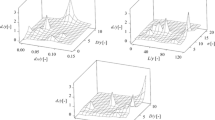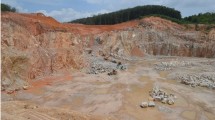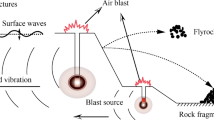Abstract
This study proposed a novel data-driven model for estimating distance of fly-rock in bench blasting in open-pit mines using a robust combination of the whale optimization algorithm (WOA), support vector machine (SVM) and kernel functions. Four kernel functions were investigated for embedding in the SVM model, including linear (L), radius basis function (RBF), polynomial (P), and hyperbolic tangent (HT) functions. Then, the WOA was applied to optimize the kernel-based SVM models, namely WOA–SVM–L, WOA–SVM–P, WOA–SVM–RBF, and WOA–SVM–HT. A variety of conventional data-driven models were also developed for predicting fly-rock distance, including adaptive neuro-fuzzy inference system (ANFIS), gradient boosting machine (GBM), random forest (RF), classification and regression tree (CART), and artificial neural network (ANN). The blasting parameters and maximum fly-rock distance, as well as their relationship, were carefully investigated for this aim. The predictive results of the models were evaluated through two performance indices: root-mean-squared error (RMSE) and correlation coefficient (R2). These indices indicated that the linear function-based WOA–SVM model (i.e., WOA–SVM–L) seems to be not fit for predicting fly-rock with the largest error (i.e., RMSE = 9.080 and R2 = 0.937). In contrast, the WOA–SVM–RBF model yielded the highest accuracy in predicting the distance of fly-rock (i.e., RMSE = 5.241, R2 = 0.977). Meanwhile, the WOA–SVM–P and WOA–SVM–HT models provided lower performances than those of the WOA–SVM–RBF model, but they are acceptable. The conventional models (i.e., ANFIS, GBM, RF, CART, and ANN) are pretty well (i.e., RMSE in the range of 5.804 to 6.567; R2 in the range of 0.965 to 0.973); however, their performance is lower than those of the WOA–SVM–RBF model as well. Based on these results, the WOA–SVM model was proposed as a useful data-driven model for predicting fly-rock with high reliability in practical engineering.













Similar content being viewed by others
References
Aljarah, I., Faris, H., & Mirjalili, S. (2018). Optimizing connection weights in neural networks using the whale optimization algorithm. Soft Computing, 22(1), 1–15.
Amini, H., Gholami, R., Monjezi, M., Torabi, S. R., & Zadhesh, J. (2012). Evaluation of flyrock phenomenon due to blasting operation by support vector machine. Neural Computing and Applications, 21(8), 2077–2085.
Armaghani, D. J., Hajihassani, M., Mohamad, E. T., Marto, A., & Noorani, S. (2014). Blasting-induced flyrock and ground vibration prediction through an expert artificial neural network based on particle swarm optimization. Arabian Journal of Geosciences, 7(12), 5383–5396.
Armaghani, D. J., Mahdiyar, A., Hasanipanah, M., Faradonbeh, R. S., Khandelwal, M., & Amnieh, H. B. (2016a). Risk assessment and prediction of flyrock distance by combined multiple regression analysis and Monte Carlo simulation of quarry blasting. Rock Mechanics and Rock Engineering, 49(9), 3631–3641.
Armaghani, D. J., Mohamad, E. T., Hajihassani, M., Abad, S. A. N. K., Marto, A., & Moghaddam, M. (2016b). Evaluation and prediction of flyrock resulting from blasting operations using empirical and computational methods. Engineering with Computers, 32(1), 109–121.
Armaghani, D. J., Momeni, E., Abad, S. V. A. N. K., & Khandelwal, M. (2015). Feasibility of ANFIS model for prediction of ground vibrations resulting from quarry blasting. Environmental Earth Sciences, 74(4), 2845–2860.
Asl, P. F., Monjezi, M., Hamidi, J. K., & Armaghani, D. J. (2018). Optimization of flyrock and rock fragmentation in the Tajareh limestone mine using metaheuristics method of firefly algorithm. Engineering with Computers, 34(2), 241–251.
Bui, H.-B., Nguyen, H., Choi, Y., Bui, X.-N., Nguyen-Thoi, T., & Zandi, Y. (2019). A novel artificial intelligence technique to estimate the gross calorific value of coal based on meta-heuristic and support vector regression algorithms. Applied Sciences, 9(22), 4868.
Bui, X.-N., Jaroonpattanapong, P., Nguyen, H., Tran, Q.-H., & Long, N. Q. (2019a). A novel hybrid model for predicting blast-induced ground vibration based on k-nearest neighbors and particle Swarm optimization. Scientific Reports, 9(1), 1–14.
Bui, X.-N., Nguyen, H., Le, H. A., Bui, H. B., & Do, N. H. (2019b). Prediction of blast-induced air over-pressure in open-pit mine: Assessment of different artificial intelligence techniques. Natural Resources Research. https://doi.org/10.1007/s11053-019-09461-0.
Chen, W., Pourghasemi, H. R., & Naghibi, S. A. (2018). A comparative study of landslide susceptibility maps produced using support vector machine with different kernel functions and entropy data mining models in China. Bulletin of Engineering Geology and the Environment, 77(2), 647–664.
Choubin, B., Moradi, E., Golshan, M., Adamowski, J., Sajedi-Hosseini, F., & Mosavi, A. (2019). An ensemble prediction of flood susceptibility using multivariate discriminant analysis, classification and regression trees, and support vector machines. Science of the Total Environment, 651, 2087–2096.
Cortes, C., & Vapnik, V. (1995). Support vector machine. Machine Learning, 20(3), 273–297.
Dou, J., Yunus, A. P., Bui, D. T., Merghadi, A., Sahana, M., Zhu, Z., et al. (2019). Improved landslide assessment using support vector machine with bagging, boosting, and stacking ensemble machine learning framework in a mountainous watershed, Japan. Landslides, 17, 641–658.
Dunteman, G. H. (1989). Principal components analysis. Thousand Oaks: Sage.
Faradonbeh, R. S., Armaghani, D. J., Amnieh, H. B., & Mohamad, E. T. (2018). Prediction and minimization of blast-induced flyrock using gene expression programming and firefly algorithm. Neural Computing and Applications, 29(6), 269–281.
Faradonbeh, R. S., Armaghani, D. J., & Monjezi, M. (2016). Development of a new model for predicting flyrock distance in quarry blasting: A genetic programming technique. Bulletin of Engineering Geology and the Environment, 75(3), 993–1006.
Ghasemi, E., Amini, H., Ataei, M., & Khalokakaei, R. (2014). Application of artificial intelligence techniques for predicting the flyrock distance caused by blasting operation. Arabian Journal of Geosciences, 7(1), 193–202.
Ghezelbash, R., Maghsoudi, A., & Carranza, E. J. M. (2019). Performance evaluation of RBF-and SVM-based machine learning algorithms for predictive mineral prospectivity modeling: Integration of SA multifractal model and mineralization controls. Earth Science Informatics, 12, 277–293.
Gui, G., Pan, H., Lin, Z., Li, Y., & Yuan, Z. (2017). Data-driven support vector machine with optimization techniques for structural health monitoring and damage detection. KSCE Journal of Civil Engineering, 21(2), 523–534.
Guo, H., Nguyen, H., Bui, X.-N., & Armaghani, D. J. (2019a). A new technique to predict fly-rock in bench blasting based on an ensemble of support vector regression and GLMNET. Engineering with Computers. https://doi.org/10.1007/s00366-019-00833-x.
Guo, H., Nguyen, H., Vu, D.-A., & Bui, X.-N. (2019b). Forecasting mining capital cost for open-pit mining projects based on artificial neural network approach. Resources Policy. https://doi.org/10.1016/j.resourpol.2019.101474.
Guo, H., Zhou, J., Koopialipoor, M., Jahed Armaghani, D., & Tahir, M. M. (2019c). Deep neural network and whale optimization algorithm to assess flyrock induced by blasting. Engineering with Computers. https://doi.org/10.1007/s00366-019-00816-y.
Hasanipanah, M., Faradonbeh, R. S., Amnieh, H. S., Armaghani, D. J., & Monjezi, M. (2017a). Forecasting blast-induced ground vibration developing a CART model. Engineering with Computers, 33(2), 307–316.
Hasanipanah, M., Armaghani, D. J., Amnieh, H. B., Majid, M. Z. A., & Tahir, M. M. (2017b). Application of PSO to develop a powerful equation for prediction of flyrock due to blasting. Neural Computing and Applications, 28(1), 1043–1050.
Hasanipanah, M., Faradonbeh, R. S., Armaghani, D. J., Amnieh, H. B., & Khandelwal, M. (2017c). Development of a precise model for prediction of blast-induced flyrock using regression tree technique. Environmental Earth Sciences, 76(1), 27.
Hudaverdi, T., & Akyildiz, O. (2017). A new classification approach for prediction of flyrock throw in surface mines. Bulletin of Engineering Geology and the Environment, 78, 177–187.
Kalogirou, S. (2007). Artificial intelligence in energy and renewable energy systems. Hauppauge: Nova Publishers.
Karabiber, A., & Alçin, Ö. F. (2019). Short term PV power estimation by means of extreme learning machine and support vector machine. In 2019 7th international Istanbul smart grids and cities congress and fair (ICSG). IEEE.
Koopialipoor, M., Fallah, A., Armaghani, D. J., Azizi, A., & Mohamad, E. T. (2019). Three hybrid intelligent models in estimating flyrock distance resulting from blasting. Engineering with Computers, 35(1), 243–256.
Le, L. T., Nguyen, H., Dou, J., & Zhou, J. (2019). A comparative study of PSO-ANN, GA-ANN, ICA-ANN, and ABC-ANN in estimating the heating load of buildings’ energy efficiency for smart city planning. Applied Sciences, 9(13), 2630.
Lundborg, N., Persson, N., Ladegaard-Pedersen, A., & Holmberg, R. (1975). Keeping the lid on flyrock in open pit blasting. Engineering and Mining Journal, 176, 95–100.
Luo, Z., Bui, X.-N., Nguyen, H., & Moayedi, H. (2019). A novel artificial intelligence technique for analyzing slope stability using PSO-CA model. Engineering with Computers. https://doi.org/10.1007/s00366-019-00839-5.
Mafarja, M. M., & Mirjalili, S. (2017). Hybrid whale optimization algorithm with simulated annealing for feature selection. Neurocomputing, 260, 302–312.
Marto, A., Hajihassani, M., Jahed Armaghani, D., Tonnizam Mohamad, E., & Makhtar, A. M. (2014). A novel approach for blast-induced flyrock prediction based on imperialist competitive algorithm and artificial neural network. The Scientific World Journal, 2014, 643715. https://doi.org/10.1155/2014/643715.
McKenzie, C. (2009). Flyrock range and fragment size prediction. In Proceedings of the 35th annual conference on explosives and blasting technique. International Society of Explosives Engineers.
Mirjalili, S., & Lewis, A. (2016). The whale optimization algorithm. Advances in Engineering Software, 95, 51–67.
Moayedi, H., Raftari, M., Sharifi, A., Jusoh, W. A. W., & Rashid, A. S. A. (2019). Optimization of ANFIS with GA and PSO estimating α ratio in driven piles. Engineering with Computers. https://doi.org/10.1007/s00366-018-00694-w.
Monjezi, M., Bahrami, A., Varjani, A. Y., & Sayadi, A. R. (2011). Prediction and controlling of flyrock in blasting operation using artificial neural network. Arabian Journal of Geosciences, 4(3–4), 421–425.
Monjezi, M., Khoshalan, H. A., & Varjani, A. Y. (2012). Prediction of flyrock and backbreak in open pit blasting operation: A neuro-genetic approach. Arabian Journal of Geosciences, 5(3), 441–448.
Nguyen, H. (2019). Support vector regression approach with different kernel functions for predicting blast-induced ground vibration: A case study in an open-pit coal mine of Vietnam. SN Applied Sciences, 1(4), 283.
Nguyen, H., & Bui, X.-N. (2018). Predicting blast-induced air overpressure: A robust artificial intelligence system based on artificial neural networks and random forest. Natural Resources Research. https://doi.org/10.1007/s11053-018-9424-1.
Nguyen, H., & Bui, X.-N. (2020). Soft computing models for predicting blast-induced air over-pressure: A novel artificial intelligence approach. Applied Soft Computing, 92, 106292. https://doi.org/10.1016/j.asoc.2020.106292.
Nguyen, H., Bui, X.-N., Bui, H.-B., & Mai, N.-L. (2018). A comparative study of artificial neural networks in predicting blast-induced air-blast overpressure at Deo Nai open-pit coal mine, Vietnam. Neural Computing and Applications. https://doi.org/10.1007/s00521-018-3717-5.
Nguyen, H., Bui, X.-N., Nguyen-Thoi, T., Ragam, P., & Moayedi, H. (2019). Toward a state-of-the-art of fly-rock prediction technology in open-pit mines using EANNs model. Applied Sciences, 9(21), 4554.
Nguyen, H., Choi, Y., Bui, X.-N., & Nguyen-Thoi, T. (2020). Predicting blast-induced ground vibration in open-pit mines using vibration sensors and support vector regression-based optimization algorithms. Sensors, 20(1), 132.
Parsaie, A., Haghiabi, A. H., & Moradinejad, A. (2019). Prediction of scour depth below river pipeline using support vector machine. KSCE Journal of Civil Engineering, 23(6), 2503–2513.
Qi, X., Chen, G., Li, Y., Cheng, X., & Li, C. (2019). Applying neural-network-based machine learning to additive manufacturing: Current applications, challenges, and future perspectives. Engineering, 5(4), 721–729.
Rad, H. N., Hasanipanah, M., Rezaei, M., & Eghlim, A. L. (2018). Developing a least squares support vector machine for estimating the blast-induced flyrock. Engineering with Computers, 34(4), 709–717.
Raina, A., Chakraborty, A., More, R., & Choudhury, P. (2007). Design of factor of safety based criterion for control of flyrock/throw and optimum fragmentation. Journal of The Institution of Engineers (India), 87, 13–17.
Rezaei, M., Monjezi, M., & Varjani, A. Y. (2011). Development of a fuzzy model to predict flyrock in surface mining. Safety Science, 49(2), 298–305.
Rostami, J., & Chang, S.-H. (2017). A closer look at the design of cutterheads for hard rock tunnel-boring machines. Engineering, 3(6), 892–904.
Shang, Y., Nguyen, H., Bui, X.-N., Tran, Q.-H., & Moayedi, H. (2019). A novel artificial intelligence approach to predict blast-induced ground vibration in open-pit mines based on the firefly algorithm and artificial neural network. Natural Resources Research. https://doi.org/10.1007/s11053-019-09503-7.
Siskind, D., & Kopp, J. (1995). Blasting accidents in mines, a 16-year summary. Cleveland: International Society of Explosives Engineers.
Tien Bui, D., Tran, C. T., Pradhan, B., Revhaug, I., & Seidu, R. (2015). iGeoTrans—a novel iOS application for GPS positioning in geosciences. Geocarto International, 30(2), 202–217.
Trivedi, R., Singh, T., & Gupta, N. (2015). Prediction of blast-induced flyrock in opencast mines using ANN and ANFIS. Geotechnical and Geological Engineering, 33(4), 875–891.
Trivedi, R., Singh, T., & Raina, A. (2014). Prediction of blast-induced flyrock in Indian limestone mines using neural networks. Journal of Rock Mechanics and Geotechnical Engineering, 6(5), 447–454.
Verakis, H., & Lobb, T. (2003). An analysis of surface coal mine blasting accidents. In Preprint for SME 2003 annual meeting, Littleton, Colorado, USA.
Wang, X., & Xing, Y. (2019). An online support vector machine for the open-ended environment. Expert Systems with Applications, 120, 72–86.
Wen, L., & Cao, Y. (2019). Influencing factors analysis and forecasting of residential energy-related CO2 emissions utilizing optimized support vector machine. Journal of Cleaner Production. https://doi.org/10.1016/j.jclepro.2019.119492.
Wu, H.-C. (2007). The Karush–Kuhn–Tucker optimality conditions in an optimization problem with interval-valued objective function. European Journal of Operational Research, 176(1), 46–59.
Zhang, X., Nguyen, H., Bui, X.-N., Tran, Q.-H., Nguyen, D.-A., Bui, D. T., et al. (2019). Novel soft computing model for predicting blast-induced ground vibration in open-pit mines based on particle swarm optimization and XGBoost. Natural Resources Research. https://doi.org/10.1007/s11053-019-09492-7.
Zhou, J., Aghili, N., Ghaleini, E. N., Bui, D. T., Tahir, M. M., & Koopialipoor, M. (2019a). A Monte Carlo simulation approach for effective assessment of flyrock based on intelligent system of neural network. Engineering with Computers. https://doi.org/10.1007/s00366-019-00726-z.
Zhou, M., Duan, N., Liu, S., & Shum, H.-Y. (2020). Progress in neural NLP: Modeling, learning, and reasoning. Engineering, 6(3), 275–290.
Zhou, T., Song, Z., & Sundmacher, K. (2019). Big data creates new opportunities for materials research: A review on methods and applications of machine learning for materials design. Engineering.
Acknowledgments
This work was supported by Basic Science Research Program through the National Research Foundation of Korea (NRF) funded by the Ministry of Education (2018R1D1A1A09083947). The authors would like to thank the Sustainable and Responsible Mining research team (SRM) of Hanoi University of Mining and Geology (HUMG), Hanoi, Vietnam, for supporting to perform this study. Also, we would like to thank the Center for Mining, Electro-Mechanical Research of HUMG, for helping us to complete this study.
Author information
Authors and Affiliations
Corresponding author
Rights and permissions
About this article
Cite this article
Nguyen, H., Bui, XN., Choi, Y. et al. A Novel Combination of Whale Optimization Algorithm and Support Vector Machine with Different Kernel Functions for Prediction of Blasting-Induced Fly-Rock in Quarry Mines. Nat Resour Res 30, 191–207 (2021). https://doi.org/10.1007/s11053-020-09710-7
Received:
Accepted:
Published:
Issue Date:
DOI: https://doi.org/10.1007/s11053-020-09710-7




